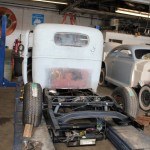1939 Chevrolet 1/2 Ton Pickup
This 1939 1/2 Ton Pickup hasn’t ever roared. Our goal for this vehicle was to get the engine running. Its engine was rebuilt in 2008, but it had never been fired, until now. We also flushed the fuel tank and tuned up the transmission.
Explore the Project Galleries
Vehicle
Chevrolet’s modern pickup era began in 1937 when management filled in the holes in the model lineups. Prior to 1937 the company produced a Commercial model (1/2-ton) and a Heavy Truck (1 1/2-ton). The gaps were closed with the introduction of 3/4- and one-ton models. Actually these new models came late in the model year in July 1937. Another interesting development was that the trucks again shared the styling traits of automobiles.
The new 3/4-ton truck had a wheelbase of 122 1/4-inches, a payload capacity of 1,500 pounds and a GVW of 5,800 pounds. The one-ton differed from the 3/4-ton in that it had larger rear brakes, heavier rear springs and bigger wheels and tires.
Available bodies included pickup, stake, and platform. The new pickup body had an inside length of 78-inches, an inside width of 45 3/4-inches and an inside height of 14-inches. Its capacity was 32.2 cubic feet or an increase of 13 percent over the 1/2-ton model.
The 1938 models carried over with only minor styling changes. Although minor, the changes to the grille and hood sides greatly enhanced the truck’s appearance. The other styling change of note was a new front bumper. The 1938 bumper was wider with a recess running down its center and it was tapered on the ends. New models for 1938 included the 3/4- and one-ton panels.
The 1939-1940 Chevrolet trucks received a restyled and reengineered cab and front sheet metal. These new trucks were by far the best looking trucks in Chevrolet Division’s history.
The new cab was designed for driver comfort and convenience. A more attractive and functional instrument panel was easier for the driver to use. Controls like choke and throttle were recessed at the lower edge of the panel at its center and the instruments were clustered for easy reading.
Seat backs in the cabs were made nearly three-inches lower and the cab provided more headroom. Softer seat springs had about two-inches of “give” to get the additional headroom. Seats were made three-inches wider, which enabled three men to sit abreast.
All 1939 models had longer wheelbases: 113 1/2-inches for the half-ton; 123 3/4-inches for the 3/4- and one-tons and 133 and 158 1/2-inches for the heavy models.
The 1939 Chevrolet Series JC Master half-ton pickup was built on a 113 1/2-inch wheelbase chassis. Chevrolet called it a “Cab and Box”. It sold for only $572 list. Road ready it weighed 2,925 pounds.
The surest way to identify a 1940 Chevrolet pickup is to look at its topmost grille bar. It is higher than that of the 1939 model and has a large Chevrolet name written in red script letters. The 1940 half-ton pickup was the Series KC Light Delivery model, which sold for only $572, or the same as the 1939 model.
There were no additions or deletions to model offerings for 1939. Although beyond the scope of our interests, Chevrolet did launch its first factory-built cab-over-engine trucks in 1939.
Read more about Chevy Trucks at: http://www.pickuptrucks.com/html/history/chev_segment3.html



